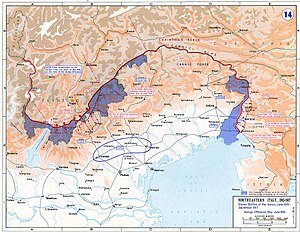Tenth Battle of the Isonzo
| Tenth Battle of the Isonzo | |||||||
|---|---|---|---|---|---|---|---|
| Part of the Italian Front of World War I | |||||||
 Eleven Battles of the Isonzo June 1915 – September 1917 |
|||||||
|
|||||||
| Belligerents | |||||||
|
|
|
||||||
| Commanders and leaders | |||||||
|
|
|
||||||
| Strength | |||||||
| 400,000 | 200,000 | ||||||
| Casualties and losses | |||||||
| 150,000 (35,000 killed) | 75,000 (17,000 killed) | ||||||
The Tenth Battle of the Isonzo was an Italian offensive against Austria-Hungary during World War I.
With nine largely unsuccessful Isonzo battles conducted within an eighteen-month period to date, Italian Chief of Staff Luigi Cadorna - responsible for launching all nine - became increasingly uncomfortable at the prospect of German intervention to aid their weakening Austro-Hungarian ally on the Italian Front.
For while it was clear that the Austro-Hungarian Army was suffering in what had become a war of attrition, the same could be said of Cadorna's army. Casualties suffered to date were tremendous and with each renewed battle tended to be higher on the Italian attackers side.
The UK's new Prime Minister, David Lloyd George, had long believed that the war could not be won on the Western Front alone. Dubbed an "easterner" at home Lloyd George was nevertheless in favour of diverting British and French resources from the Western Front to the Italians along the Soča (Isonzo), to "knock the props out" from under the Central Powers.
However Lloyd George's own field commanders, including Commander in Chief Douglas Haig - along with the French - disagreed, arguing that resources could not be spared from the Western Front, particularly with French Commander-in-Chief Robert Nivelle's upcoming Aisne Offensive, aimed at ending the war in the west within 48 hours.
Consequently, Nivelle dispatched Ferdinand Foch to meet with Cadorna and discuss their possible options. In the event the British and French agreed to rush aid to the Italians only in the event of an emergency - for example, large-scale German military assistance to the Austro-Hungarians; a contingency plan was thus developed to meet with such an eventuality.
The agreed plan was duly invoked - too late - in late October 1917 in the wake of the Italians' disastrous performance at Caporetto in the Twelfth Battle of the Isonzo.
...
Wikipedia
